Males are good flyers, nymphs are gliders
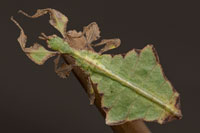
That adult males can fly quite well for some distance, that is common knowledge. Therefore we better watch open windows when a Phyllium cage with adult males is open....
Yet hitherto hardly known is that both male and female Phyllium nymphs can "fly" too. They can glide, like a paraglider. This is possible due to their broad leaf-like, and very flat body shape, which gives them a big body surface compared to their low weight. Therefore Phyllium nymphs do not drop down like a stone, but they glide like a leaf through air. And this effect is even more pronounced in older nymphs, as their body is even broader. By "paragliding" they might cover quite a distance, if they are blown out of a tree top, during a storm for example. This effect does no more work once the females are adult, as by then they are too heavy. Especially in Phyllium giganteum nymphs, this "paraglyding" effect can be observed is very clearly. Just drop a nymph like for example from the ceiling of your room, and observe it gliding through the air.
Expanding the abdomen
While "stick-like" phasmid nymphs extend their length shortly after hatching, Phyllium nymphs expand / broaden their abdomen quite a bit. During this expanding / broadening process they slowly move their abdomen in a wavy motion. Here are two videos:
1.
(time lapse video by Hsin-Hsiung Chen, Taiwan)
2.
(real-time video by Bruno Kneubühler)
Different appearances within the same population
even within the same population, there are specimens with different morphological characteristics
- an example for Phyllium westwoodii "Southern Wang Sombun"
- there are male and female specimens with no sign of dark dots ("eyes") on their abdomen, while there are specimens with clear such markings as well as intermediate forms
- male nymphs might have or lack brown midlegs, sometimes even female nymphs have brown mid legs. Thus the presence or absence of brown midllegs is no reliable characteristic for distinguishing male and female nymphs


- non-green, yellow, brown or orange Phyllium females are wellknown
- Phyllium (Pulchriphyllium) males usually green just after their adult moult, and then they gradually change their color to yellow (about 3 - 4 weeks later). Here an example, an adult Phyllium giganteum "Tapah" male (about 4 weeks old):
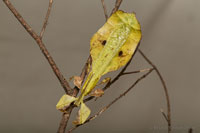
- Phyllium (Phyllium) males are very rarely non-green, most Phyllium (Phyllium) males remain green throughout their whole adult life . Below an orange male of Phyllium elegans "Nanga Nanga"
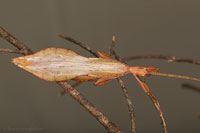
Fringes on Phyllium eggs
Eggs of all Phyllium (Phyllium) species we had so far in culture have fringes / bristles, while eggs of Phyllium (Pulchriphyllium) lack such fringes. Following an example - Phyllium (Phyllium) sp. "Bukit Daun, blue coxae" (below top, eggs with fully expanded fringes) and Phyllium (Pulchriphyllium) giganteum "Tapah" eggs (below bottom)
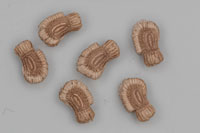
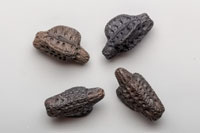
These fringes seem be a valuable taxonomic criterion. They can be rather long, for example in the Ph. hausleithneri species group (see eggs of Phyllium (Phyllium) sp. "Bukit Daun, blue coxae" above). Or else these fringes are rather short, giving such eggs velvety look. Examples for short fringes are Phyllium (Phyllium) westwoodii "Tha Pla Duk" (below top) and Phyllium (Phyllium) chrisangi "Singapore" (below bottom)
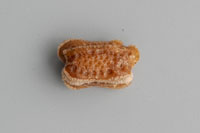
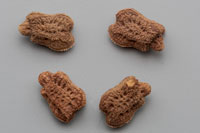
Maybe these short fringes in the westwoodii and celebicum species group is an indication that there is room for at least another subgenus?
On freshly laid eggs, these fringes are not yet expanded. They will expand once the egg is getting in contact with a humid or wet environment for some time. The pic below depicts a freshly laid egg of Phyllium (Phyllium) sp. "Bukit Daun, blue coxae" (left), and the same egg after having been in contact with a humid substrate for some time
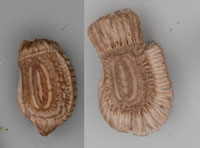
Another graphic illustration of this expansion process. The pic below shows the whole process on a Phyllium rubrum "Tapah" egg. The whole process takes about 2 hours (for this species), while it is takes about 1 hour Ph. hausleithneri "Tapah Hills":
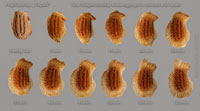
And a final example - unexpanded (below top) and expanded fringes (below bottom) on eggs of Phyllium hausleithneri "Tapah Hills" (left) and Phyllium rubrum "Tapah Hills" (right)
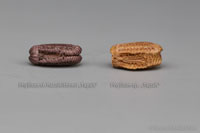

The potential biological significance of these fringes could be that they anchor the egg in layer of moss. And this could be a vital protection, as moss provides some shelter (e.g. from being spotted by predators) and supplies some humidity. Furthermore do these fringes have the capacity to "draw water", like blotting paper. Here a time lapse video of this process (about 12 minutes in real time):
Overall Phyllium egg morphology (with expanded and non-expanded fringes) seems to be a valuable yet (up until now) overlooked taxonomic criterion.